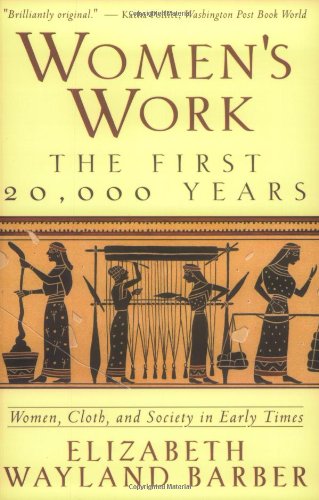Sunday, January 3, 2016
Book Review: Women's Work: The First 20,000 Years
Women's Work--The First 20,000 Years: Women, Cloth, and Society in Early Times by Elizabeth Wayland Barber.
Women's Work is a history book aimed at general audiences; I found it a pleasant and informative read. It traces the development of spinning and weaving from the stone age up to about 500 b.c.e. Tapping into linguistics, archaeology, folklore, ethnography, mythology, dance, and comparisons to modern fiber arts, Dr. Barber creates a working narrative of how textiles developed, and how women's roles changed with them. Original cloths and fiber-working tools also figure prominently into the story.
While being highly accessible, I think this book also does a good job of including documentation without interrupting the narrative. Particularly in the earliest years covered, actual textiles and tools are scarce; however, the author does an excellent job of finding indirect evidence and explaining the conclusions drawn from it. The twelfth chapter is devoted to methodology, and an extensive source list is also included.
The book is arranged chronologically, with the later chapters (covering better-documented times) also divided by geographic region: Minoan, Assyrian, Egyptian, Greek and northern and eastern European textiles each get special attention. Certain themes, such as the economic status of the textile workers or the purpose of decorating fabric, are revisited throughout, making a more cohesive work.
I agree that this was the best way to handle the information available, though one sometimes needs to take a moment and remember when and where the narrative is in space-time.
People already familiar with archaeological dating terms and basic fiber-working processes may find the introduction a little slow. Likewise, if you hated reading the The Odyssey, parts of chapters 4 and 9 may not be fun, though I enjoyed them immensely (and had forgotten just how much textile work is mentioned beyond Penelope's weaving).
Score: 5 Stars
Accuracy: High. Many images and sketches of original items are included. The extensive source list provides many options for further reading.
Strongest Impression: This is a popular textile history book: less dense that Prehistoric Textiles, but still full of examples from history. The author explains her reasoning well, and makes a compelling case for her history of textile development. I especially liked the quotations from Assyrian business correspondence, and Wayland-Barber's interpretation of select scenes from The Odyssey. and European folk-tales. A must-read for anyone interested in early cloth-making.
Labels:
book review,
spinning,
weaving
Subscribe to:
Post Comments (Atom)

No comments:
Post a Comment
Thanks for commenting!